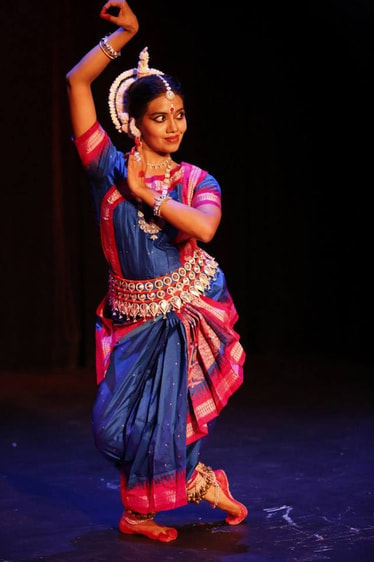OdissiOdissi is a classical dance that originated in Odisha, India Odissi (Odia: Oṛiśī), also referred to as Orissi in older literature, is a major ancient Indian classical dance that originated in the Hindu temples of Odisha – an eastern coastal state of India. Odissi, in its history, was performed predominantly by women, and expressed religious stories and spiritual ideas, particularly of Vaishnavism (Vishnu as Jagannath). Odissi performances have also expressed ideas of other traditions such as those related to Hindu gods Shiva and Surya, as well as Hindu goddesses (Shaktism).
Modern Odissi is performed by children and adults, in solo or as group. Above is the Tribhanga posture of Odissi. The theoretical foundations of Odissi trace to the ancient Sanskrit text Natya Shastra, its existence in antiquity evidenced by the dance poses in the sculptures of Odissi Hindu temples, and archeological sites related to Hinduism, Buddhism and Jainism. The Odissi dance tradition declined during the Islamic rule era, and was suppressed under the British Rule.The suppression was protested by the Indians, followed by its revival, reconstruction and expansion since India gained independence from the colonial rule. Odissi is traditionally a dance-drama genre of performance art, where the artist(s) and musicians play out a mythical story, a spiritual message or devotional poem from the Hindu texts, using symbolic costumes, body movement, abhinaya (expressions) and mudras (gestures and sign language) set out in ancient Sanskrit literature.Odissi is learnt and performed as a composite of basic dance motif called the Bhangas (symmetric body bends, stance). It involves lower (footwork), mid (torso) and upper (hand and head) as three sources of perfecting expression and audience engagement with geometric symmetry and rhythmic musical resonance. An Odissi performance repertoire includes invocation, nritta (pure dance), nritya (expressive dance), natya (dance drama) and moksha (dance climax connoting freedom of the soul and spiritual release). Traditional Odissi exists in two major styles, the first perfected by women and focussed on solemn, spiritual temple dance (maharis); the second perfected by boys dressed as girls (gotipuas) which diversified to include athletic and acrobatic moves, and were performed from festive occasions in temples to general folksy entertainment. Modern Odissi productions by Indian artists have presented a diverse range of experimental ideas, culture fusion, themes and plays. Fun Fact: Odissi was the only Indian dance form present in Michael Jackson's 1991 hit single Black or White. *Text from Wikipedia |
Classes
Beginner (Level 1)
Students will learn the fundamental principles of Odissi in the style of Guru Kelucharan Mohapatra, including the basic steps in the two distinctive positions – Chauka (the square stance) and Tribhangi (the three-bend stance). These will be woven together with traditional hand gestures, walks, turns, neck, eye and head movements in a simple choreography – Sthayi (traditional pure dance sequence) – to create an enjoyable practice for young beginners with the aim of exposing them to the experience of performance and ensemble work. Students will also learn to chant the basic eight beat bols, and learn about the history of Odissi.
Beginner II (Level 2-4)
The Chauka and Tribhangi steps set to eight to ten beat cycles will be introduced and added to the Sthayi choreography. Torso movement will be taught at this stage for each of the ten basic Chauka and Tribhangi steps. Students will also learn the choreography for a Vandana (hymn) as an introduction to Mangalacharan, the traditional invocatory piece which forms part of the Odissi repertoire.
Intermediate (Level 5-7)
Mangalacharan's rhythmic sequence of steps forming the Bhumi Pranam (salutation to Mother Earth) and Trikhandi Pranam (three-fold salutation to God, the Guru, and the audience) will be completed. This class will focus on learning the basic items of the Odissi repertoire – Batu Nritya and Pallavi (pure dance sequences), and Moksha (the dance of salvation which concludes a performance).
Students will learn the fundamental principles of Odissi in the style of Guru Kelucharan Mohapatra, including the basic steps in the two distinctive positions – Chauka (the square stance) and Tribhangi (the three-bend stance). These will be woven together with traditional hand gestures, walks, turns, neck, eye and head movements in a simple choreography – Sthayi (traditional pure dance sequence) – to create an enjoyable practice for young beginners with the aim of exposing them to the experience of performance and ensemble work. Students will also learn to chant the basic eight beat bols, and learn about the history of Odissi.
Beginner II (Level 2-4)
The Chauka and Tribhangi steps set to eight to ten beat cycles will be introduced and added to the Sthayi choreography. Torso movement will be taught at this stage for each of the ten basic Chauka and Tribhangi steps. Students will also learn the choreography for a Vandana (hymn) as an introduction to Mangalacharan, the traditional invocatory piece which forms part of the Odissi repertoire.
Intermediate (Level 5-7)
Mangalacharan's rhythmic sequence of steps forming the Bhumi Pranam (salutation to Mother Earth) and Trikhandi Pranam (three-fold salutation to God, the Guru, and the audience) will be completed. This class will focus on learning the basic items of the Odissi repertoire – Batu Nritya and Pallavi (pure dance sequences), and Moksha (the dance of salvation which concludes a performance).

